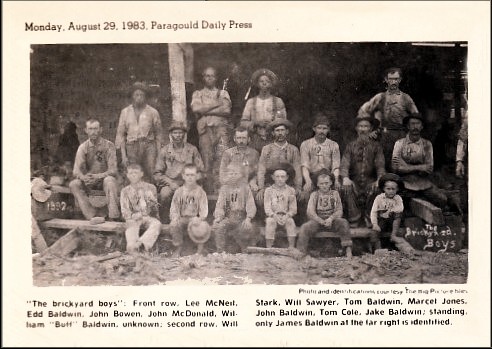
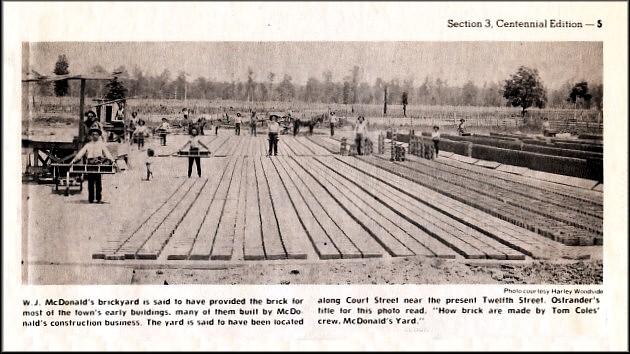
Photo and identifications courtesy The Big Picture files
Greene County Arkansas
Paragould, Arkansas
Centennial Edition Section 3
=============================================================================================================
|
Monday, August 29, 1983~Paragould Daily Press |
 |
 |
|
|
Photo and identifications courtesy The Big Picture files |
||
| "The brickyard boys": Front row, Lee McNeil, Edd Baldwin, John Bowen, John McDonald, William "Buff" Baldwin, unknown; second row, Will Stark, Will Sawyer, Tom Baldwin, Marcel Jones, John Baldwin, Tom Cole, Jake Baldwin; standing, only James Baldwin at the far right is identified. | W.J. McDonald's brickyard is said to have provided the brick for most of the town's early buildings, many of them built by McDonald's construction business. The yard is said to have been located along Court Street near the present Twelfth Street. Ostrander's title for this photo read, "How brick are made by Tom Coles' crew, McDonald's Yard. |
| 1892 |
| brought to you by |
| Ostrander's Gallery |
| It was 1892 and the incorporated town of Paragould
was less than 10 years old. Electric lights had just been installed
by the investor-owned Paragould Electric Light and Power Co., the
town had purchased a $720 hand-pump fire engine and the council had
contracted with W. L. Lawrence to "do the scavenger work of private
house." Early the following year, an 1893 special census would report the town's population to be 2,528. Those facts are from Vivian Hansbrough's History of Greene County. But other interesting facts about 1892 Paragould can be drawn from the surviving photographs that bear the inked stamp of Ostrander's Gallery. The Baptist Church was getting a new coat of paint. Mitchell's Point was the place to go for a family fishing outing. The McDonald's brick yard was keeping busy. H. Ostrander (the first initial appears on only one of these photographs) was one of the now-mysterious photographers whose surviving pictures provide us a vivid look at Paragould's early days. Fortunately, the photographer often captioned and dated his pictures. But, unfortunately, we don't know much more about many of the photographs than what he etched into the negatives. Nor do we know much more about the photographer than he told us on the simple stamp he used to credit his work. We know, for |
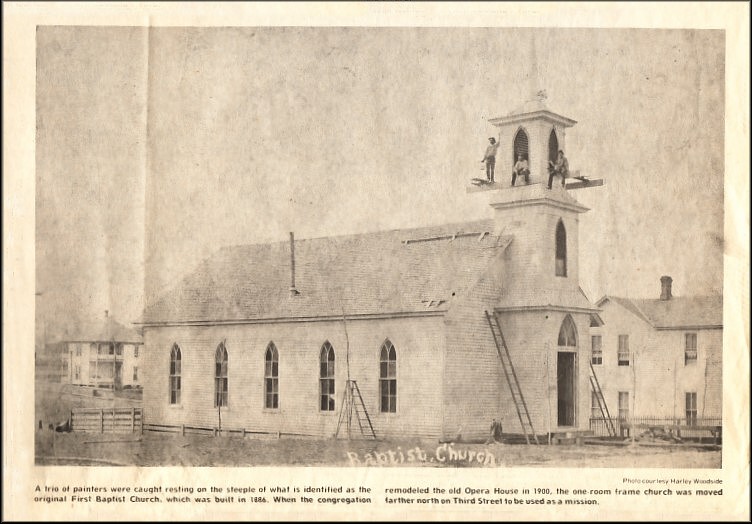 |
|
| instance that he was in business here during 1892, |
Photo courtesy Harley Woodside |
|
| for that year is noted on many of his pictures. In fact, it is the only year noted on those we have seen. | A trio of painters were caught resting on the steeple of what is identified as the original First Baptist Church, which was built in 1886. When the congregation remodeled the old Opera House in 1900, the one- room frame church was moved farther north on Third Street to be used as a mission. | |
| Unlike the surviving works of several other early | ||
| photographers, Ostrander's photographs are more | ||
| studio portraits. They feature the town's early | ||
| buildings and outdoor activities. Ostrander photo- | ||
| graphs included elsewhere in this special edition include the old wooden depot, the original Westside School, Dr. R.C. Grizzard's Paragould brass band and a delightful studio portrait of unidentified twins. | ||
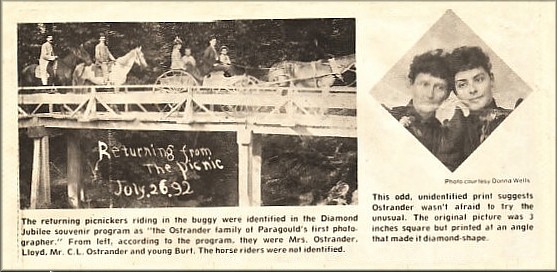 Photo courtesy Donna Wells The returning picnickers riding in the buggy were identified in the Diamond Jubilee souvenir program as "The Ostrander family of Paragould's first photographer." From left, according to the program, they were Mrs. Ostrander, Lloyd. Mr. C. L. Ostrander and young Burt. The horse riders were not identified. This odd, unidentified print suggests Ostrander wasn't afraid to try the unusual. The original picture was 3 inches square but printed at an angle that made it diamond-shape. |
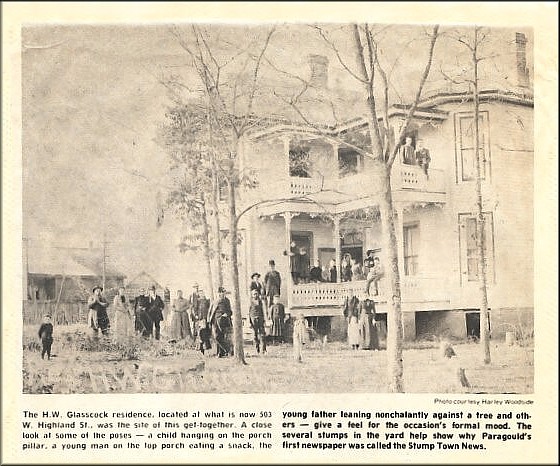 |
|||
|
Photo courtesy Harley Woodside |
||||
| The H. W. Glasscock residence, located at what is now 503 W. Highland St., was the site of this get-together. A close look at some of the posers-a child hanging on the porch pillar, a young man on the top porch eating a snack, the young father leaning nonchalantly against a tree and others-give a feel for the occasion's formal mood. The several stumps in the yard help show why Paragould's first newspaper was called the Stump Town News. | ||||
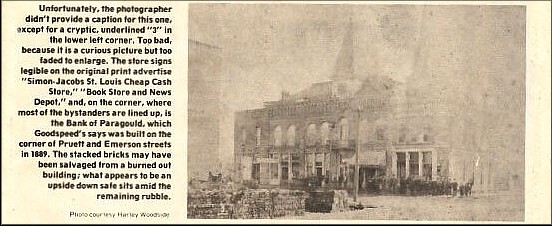 |
Unfortunately, the
photographer didn't provide a caption for this one, except for a
cryptic, underlined "3" in the lower left corner. Too bad,
because it is a curious picture but too faded to enlarge. The store
signs legible on the original print advertise "Simon-Jacobs St.
Louis Cheap Cash Store," "Book Store and News Depot," and on the
corner, where most of the bystanders are lined up, is the Bank
of Paragould, which Goodspeed's says was built on the corner of
Pruett and Emerson streets in 1889. The stacked bricks may have been
salvaged from a burned out building; what appears to be an upside
down safe sits amid the remaining rubble.
|
|||
|
Photo courtesy Harley Woodside |
||||
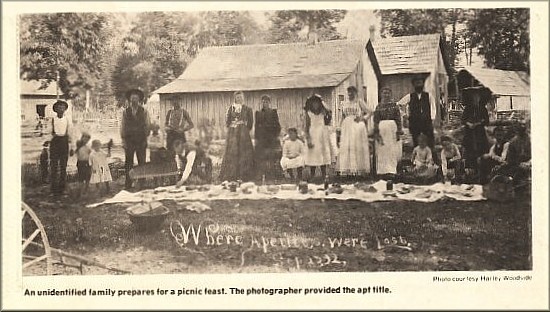 |
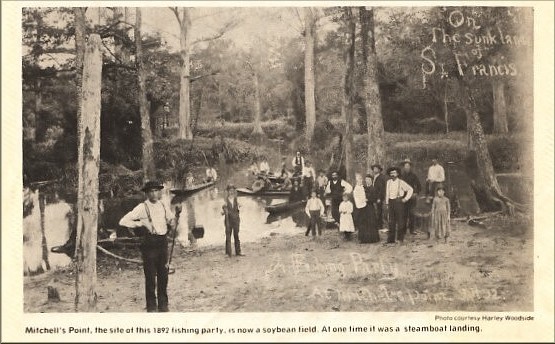 |
|||
|
Photo courtesy Harley Woodside |
Photo courtesy Harley Woodside |
|||
| An unidentified family prepares for a picnic feast. The photographer provided the apt title. | Mitchell's Point, the site of this 1892 fishing party, is now a soybean field. At one time it | |||
|
" Where apetites were Lost" |
was a steamboat landing. | |||
Transcribed from the 1983 Centennial Edition by : PR Massey
Return to Greene County, Arkansas Centennial Edition
Return to Greene County, Arkansas Newspapers
Return to Greene County, Arkansas Index Page
©2010 PR Massey